Since 1990, November has been recognized across the United States as Native American Heritage Month.
In Pennsylvania, the story of the Native American peoples who lived in what is now the commonwealth is largely told through archaeology and the sites and artifacts that are uncovered across the landscape.
This story, which is still unfolding, is complex, rich, and varied and I can’t begin to do it justice in just one blog post. What I can do, however, is provide you with a snapshot of what archaeology tells us about Native American history in Pennsylvania and hopefully inspire you to learn more.
Native American Heritage in Pennsylvania
The following excerpt is from “Highlights of Pennsylvania Archaeology” in Pennsylvania’s 2018-2023 Statewide Historic Preservation Plan. Links to learn more about Native American heritage in Pennsylvania are included at the end of this post.
Pre-Contact Period
The pre-contact period is generally considered before 1550, when the first Europeans visited the North American continent. Pre-contact sites provide insight into the early settlement of North America, environmental adaptation, and Native American culture.
Archaeological research in Pennsylvania takes our understanding back to the earliest known human occupation in North America. Some Pennsylvania sites have even yielded evidence suggesting an earlier human presence than archaeologists had traditionally assumed.
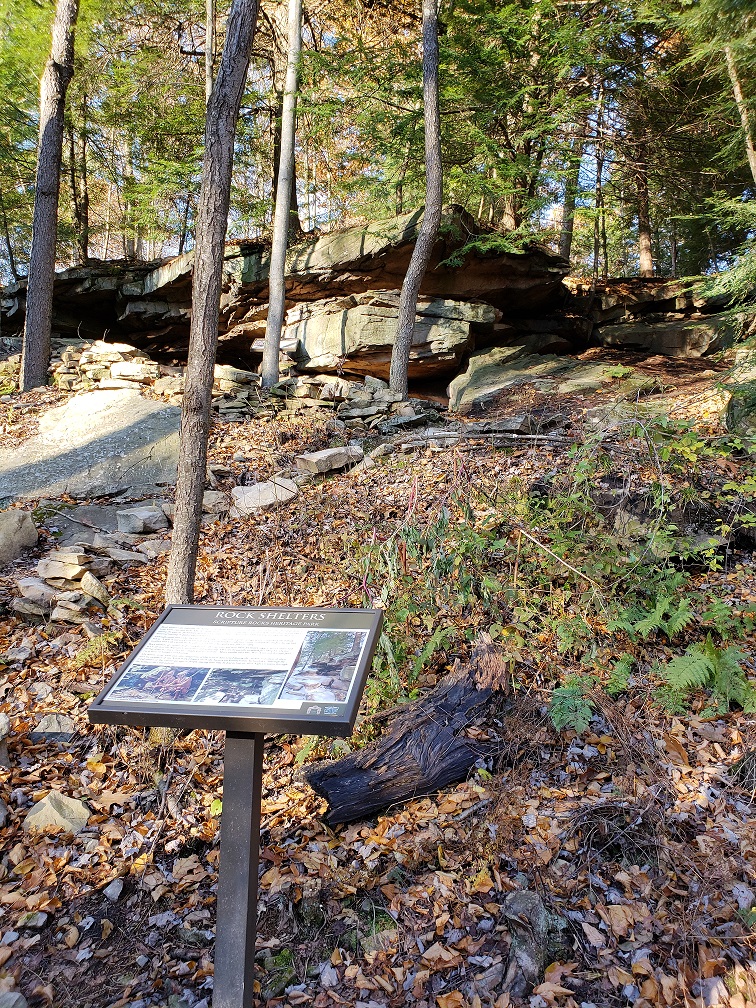
During the Paleoindian period, 16,500 to 10,000 years ago, Native Americans lived in small,mobile bands that were well-adapted for hunting and foraging within the cold, glacial environment.
The oldest site in Pennsylvania, Meadowcroft Rockshelter in Washington County, includes Paleoindian components dating to at least 16,000 years ago. Excavation of this complex site revealed intact cultural layers spanning thousands of years and yielded significant information about Paleoindian diet and technology. Because of its importance, Meadowcroft was recognized as a National Historic Landmark in 2005.
Other significant Paleoindian sites include Shawnee-Minisink in Monroe County and Shoop in Dauphin County. Shawnee-Minisink is the second oldest site in Pennsylvania. Because it contained intact Paleoindian hearth features, the site changed our understanding of the spread of Clovis culture and yielded significant information about the Pleistocene environment and diet. A Pennsylvania Historical Marker was dedicated to Shawnee-Minisink
in 2010.
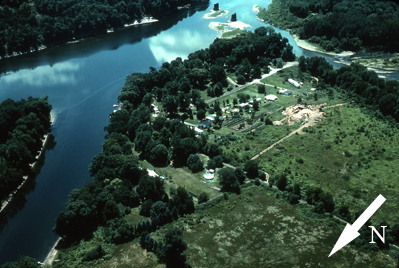
Shawnee-Minisink site 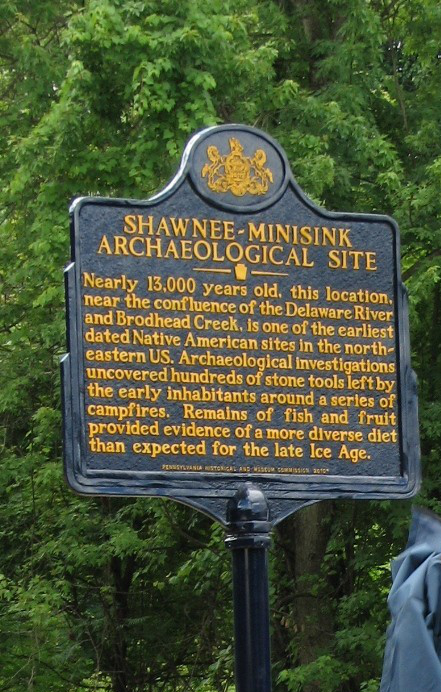
Historical marker for Shawnee-Minisink site 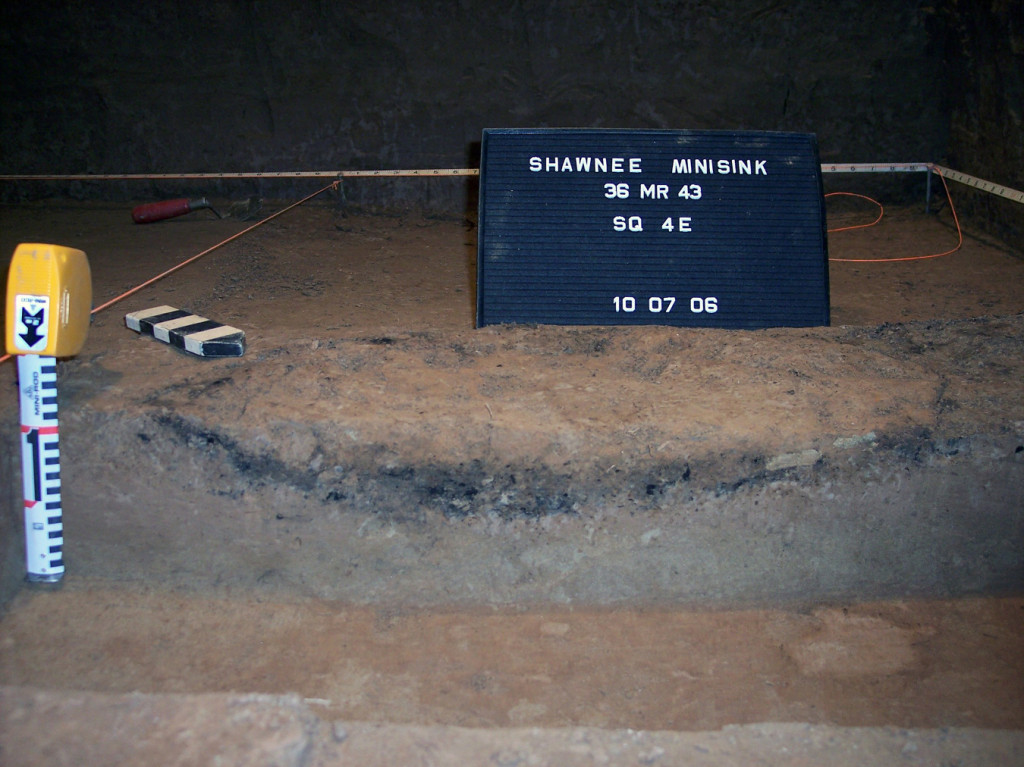
Profile of hearth feature in Unit 4E; note the charcoal
The Archaic period in Pennsylvania spans from about 10,000 to 4,300 years ago. A warmer, drier climate dominated during this time. Excavations have revealed changes in stone tools, larger social groupings, and a diet that relied heavily on the plant-based foods available in the forests, swamps and grassland that developed after glacial retreat.
The Lower Black Eddy site, located along the Delaware River in Bucks County, represents an Archaic base camp with easy access to the river and to tool stone sources like the nearby Point Pleasant argillite quarry.
City Island in the Susquehanna River in Dauphin County was a seasonally occupied camp, with artifacts such as net sinkers showing the dietary importance of fishing. Although there are fewer stratified Archaic sites in the western part of Pennsylvania, significant finds have included Goddard in Mercer County and Kinsinger in Somerset County—both of which
contained post features from houses.
Following the Archaic period, increased population and environmental changes enabled gradual culture change in portions of Pennsylvania. The Transitional period, 4,300 to 2,700 years ago, saw increased trade and the use of steatite vessels for cooking food. Transitional components have been identified at stratified sites, such as City Island, Leetsdale in Allegheny County, and Piney Island in Lancaster County, with the greatest concentrations documented in the Susquehanna River basin.
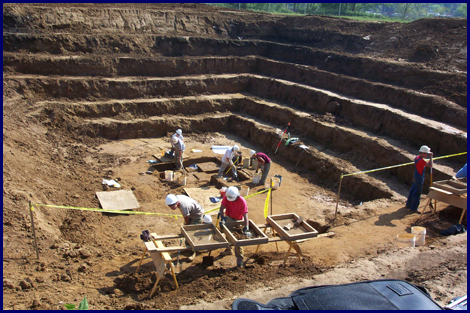
If the Transitional period represented a gradual and regionalized shift from Archaic-period lifeways, the Woodland period (2,700 to 1,550 years ago) saw widespread adoption of new behaviors such as plant cultivation, consolidation into larger groups and villages, regiona trade, and the use of pottery vessels.
Archaeologists also have identified individual cultural groups that lived in Pennsylvania, as well as regional connections with other cultures in North America. For example, the Pitt Gas burial mound in Greene County contains artifacts from the Meadowood phase that originated in New York and the Adena cultures in Ohio and Mississippi. Most burial mounds are found in the Ohio drainage, with fewer numbers in central Pennsylvania associated with the Late Woodland Clemson Island culture.
Another site type that emerged during the Woodland period is the village, which formed as people started living in larger, more sedentary groups. From these sites, archaeologists learn significant information about family and social organization, Pre-Contact architecture, food processing and storage, burial practices, and warfare. Examples include Monongahela villages, like Consol in Westmoreland County and Johnston in Indiana County, and Shenks Ferry villages, like Murry and Quaker Hills Quarry in Lancaster County.
Some Pre-Contact sites are hard to associate with specific cultures and periods, but they are highly important because they show us aspects of Native American life that are not usually seen in the archaeological record.
Sheep Rock Shelter in Huntingdon County is one of the most unique sites
ever excavated in Pennsylvania. Its historically dry conditions led to the remarkable preservation of artifacts that are rarely found—woven cordage, bark basketry, and decorated bone knife handles—illustrating a wider range of Native American lifeways than can be reconstructed from
stone tools.
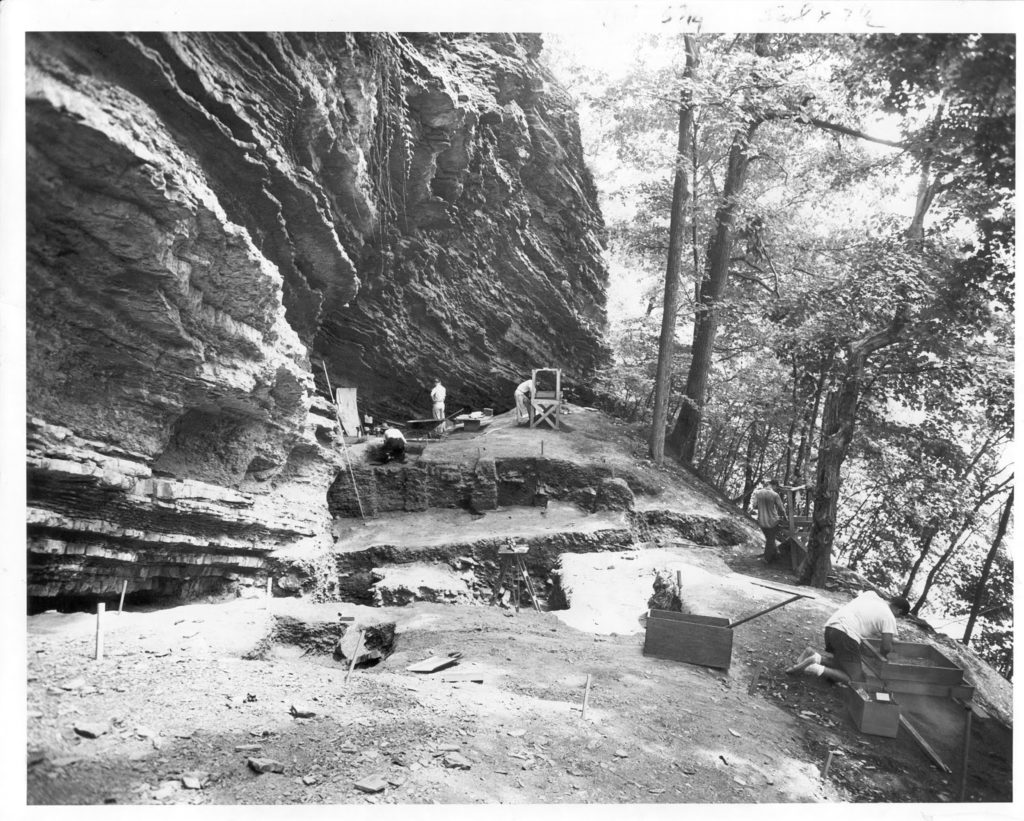
Although the site is now submerged under Raystown Lake, a small portion was modelled as an exhibit in The State Museum of Pennsylvania. Similarly, petroglyph sites allow us to look beyond technology and subsistence to examine the less-tangible aspects of culture, such as symbolism,
ceremony and religion. Examples include Big and Little Indian Rock in the Susquehanna River, Lancaster County, and Indian God Rock in the Allegheny River, Venango County
Contact Period
Archaeology of the Contact period, spanning between 1550 and 1750, studies the interaction between Native groups and Europeans and the eventual demise or displacement of the Susquehannock and Delaware tribes that lived in southeastern and central Pennsylvania.
Tribal conflict, European trade, disease, and the occupation of Native lands by European settlers led to tremendous culture change. Through the excavation of Contact period Native American villages, such as the Susquehannock sites around Washington Borough in Lancaster County and Memorial Park in Cumberland County, archaeologists have traced the movements and cultural changes of the Susquehannock people during the 16th and 17th centuries.
Villages from the so-called Refugee period (18th century) provide insight into the last Native occupations. A handful of sites in Beaver and Lawrence counties show the westward movement of the Delaware. Conestoga Town in Lancaster County was the final settlement of the Susquehannocks before they were massacred in 1763.
Although the Contact period ends in the mid-18th century, additional sites tell the story of Pennsylvania’s continued interactions with Native groups through westward expansion, the French and Indian War, and the Revolutionary War.
Examples include the Revolutionary War-era Queen Esther’s Town in Bradford County and the Cornplanter Grant in northwestern Pennsylvania, which was occupied by the Seneca until the construction of the Kinzua Dam in the 1960s.
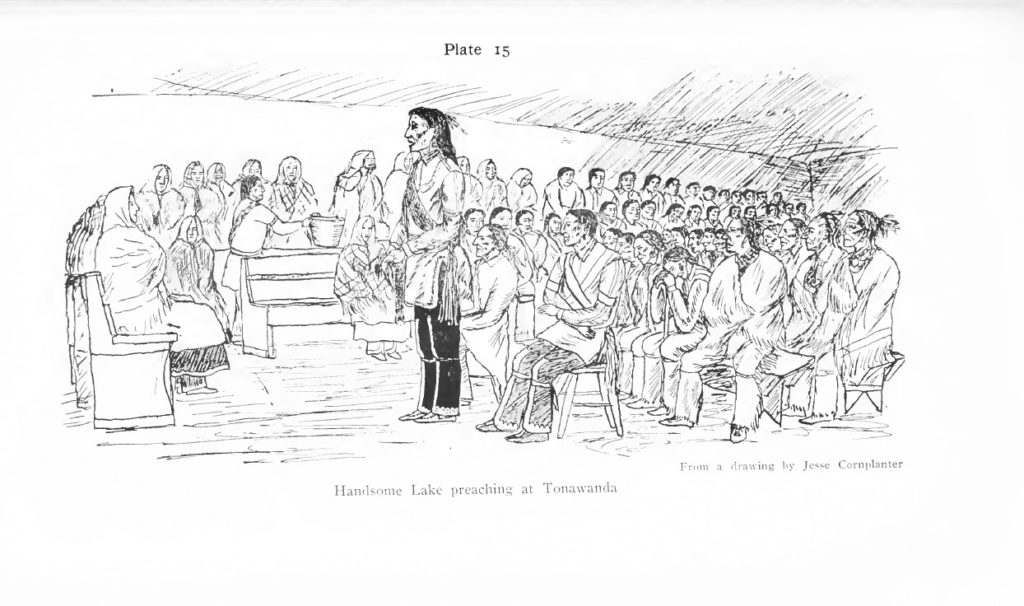
“Handsome Lake Preaching at Tonawanda” by Jesse Cornplanter from “The code of Handsome Lake, the Seneca prophet” by Arthur C. Parker. Full book available at https://archive.org/details/codeofhandsomela02hand 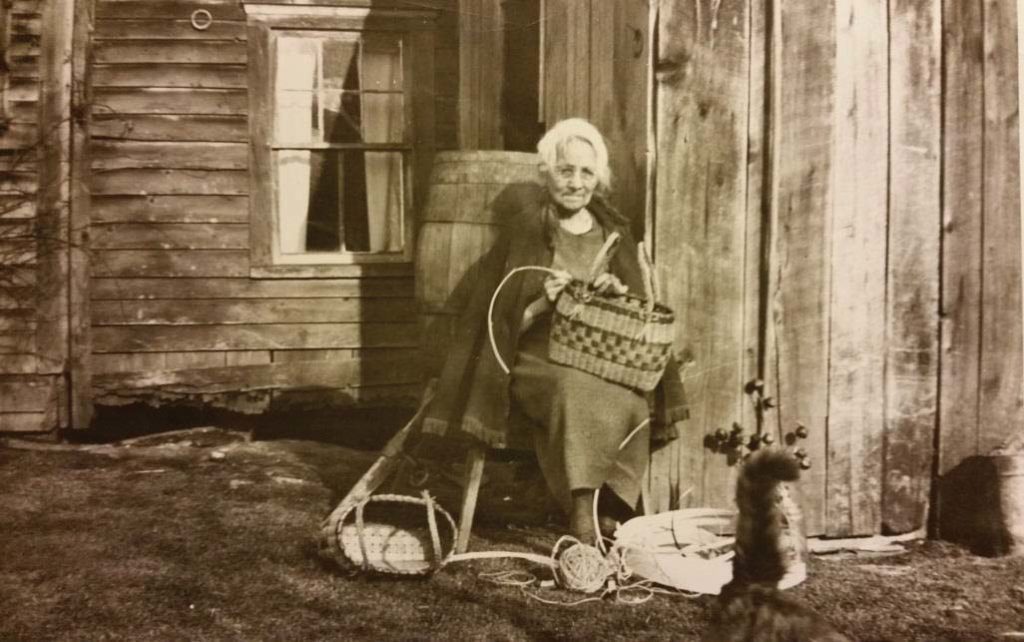
Phoebe Gordon making baskets at the Cornplanter Grant. Ms. Gordon is constructing a two-handled, split-oak basket. Photo courtesy of the Deardorff Archive, Warren County Historical Society. 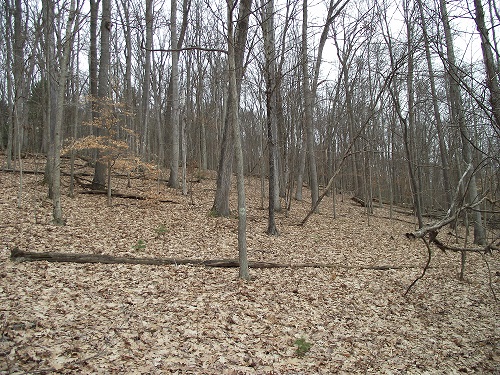
Current view of the southern end of the Cornplanter Grant today Image courtesy of Chris Espenshade, taken February 28, 2017.
Learn more
There is so much that we didn’t touch on in this short post and so much more to learn. Here are just some online resources to explore if you’re interested in learning more about Native American heritage and culture in Pennsylvania, their achievements, contributions and sacrifices, and more.
PA SHPO’s Blog
We frequently cover topics related to Native American history in this blog throughout the year. Here are just a few examples:
- Finding Meaning in Stone (2020)
- Mapping the Wallace Paths in CRGIS (2019)
- The Cornplanter Grant: The Last Native American Settlement in Pennsylvania (2018)
- McKees Rocks Mound (2015)
- Remembering Indian Hannah (2014)
- The Shawnee-Minisink Archaeological Site (2014)
National Register of Historic Places
For researching Native American history, CRGIS provides links to Historic Resource Survey Forms (HRSFs) and National Register nominations for archaeological sites and other types of properties associated with Native American history. In addition to including a history and significance of a place, these documents often have bibliographies that can lead readers to other primary and secondary resources.
There are several pre-contact and contact-period sites in Pennsylvania listed in the National Register of Historic Places or designated as National Historic Landmarks. A historic name search often yeilds the best results. Check out some of these sites and their nominations to learn more.
- Big and Little Indian Rock Petroglyphs, Lancaster County
- Book Site, Juniata County
- Calver Island, Dauphin County
- Clemson Island Prehistoric District, Dauphin County
- Fisher Site, Greene County
- Francis Farm Petrogylphs Site, Fayette County
- Sommerheim Park Archaeological District, Erie County
A quick note: For some archaeolgoical sites, sensitive information in the National Register form, like location, may be blacked-out to protect from looting and other vandalism.
Another quick note: I normally add links to National Register forms and other records in CRGIS for posts like this one. However, because we are in the countdown to PA-SHARE and CRGIS will be sunsetting soon, I haven’t this time. You can find these sites in CRGIS through an Ask ReGIS search.
PHMC’s Online Resources
The State Museum of Pennsylvania and Pennsylvania Heritage magazine are also great sources of information. Here are just a few examples of their offerings related to Native American history in Pennsylvania:
- PA Trails of History YouTube videos, specifically:
- Native American Archaeology website
- This Week in Pennsylvania Archaeology blog
- Articles in Pennsylvania Heritage Magazine (now online!), like:
- Indian Hannah (2015)
- The Carlisle Indian Industrial School (2013)
- Books and publications available through shopPAHeritage.com and many local libraries:
- First Pennsylvanians: The Archaeology of Native Americans in Pennsylvania. (2015) by Senior Curator of Archaeology at the State Museum of Pennsylvania Curator Kurt Carr and Roger W. Moeller for general readership.
- Indian Paths of Pennsylvania (2018, reprint) by Paul A.W. Wallace describes and maps 131 historic Indian trails throughout Pennsylvania.
PHMC’s Museum Collection
Argus, the online museum collection is a relatively new addition to the PHMC website. Using the simple keyword search, I found over 400 items related to Native American history in Pennsylvania.
Argus is a work in progress and these records represent a small fraction of the Pennsylvania Historical and Museum Commission (PHMC) collection. We are constantly working to expand public access. This site will be updated as we research our objects and improve our records.
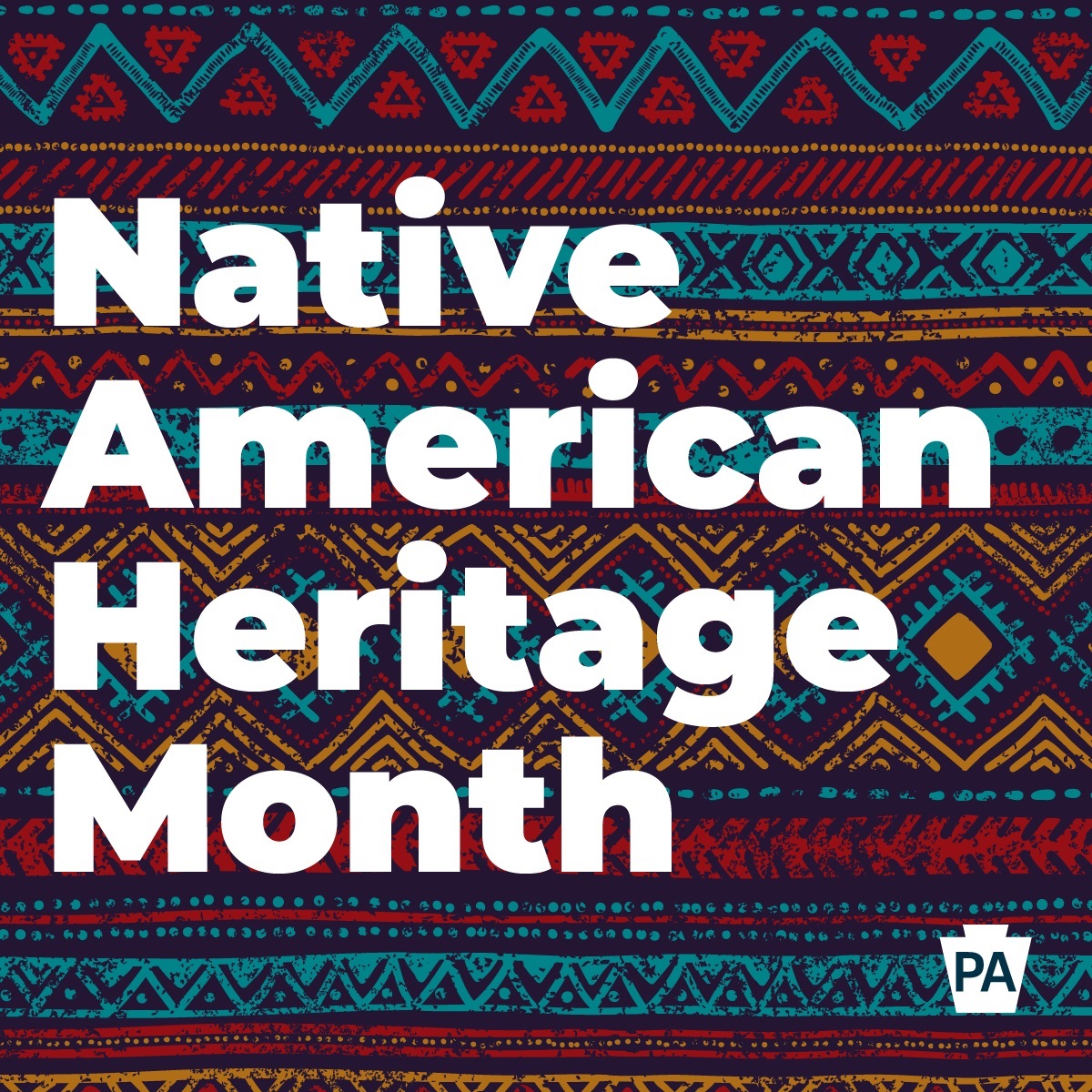
What if one discovers….or suspects spotting a mound??
Try contacting these offices:
PA SHPO- (717) 787-3362
Check and see if they already have information on the site here: https://www.phmc.pa.gov/Preservation/survey/Pages/Archaeology.aspx
One of the chapters for the Society of Archaeology in PA https://www.pennsylvaniaarchaeology.com/Chapters.htm
PAC https://pennarchcouncil.org/contact-pac/